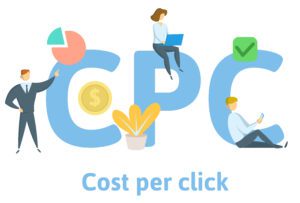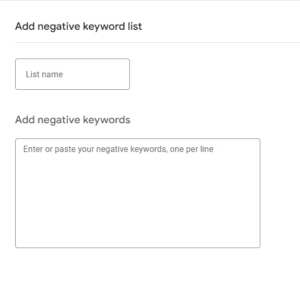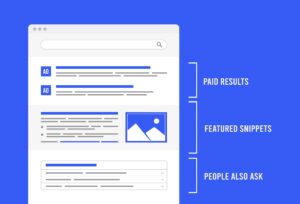
PPC Glossary of Terms

Like SEO, PPC (Pay-per-click) is a digital marketing strategy to boost organic traffic to a company’s website. Advertisers do this by placing ads on external online platforms and pay a fee every time a user clicks on that ad because it increases the chance that they’ll receive revenue in the form of a sale from their website.
If you’re reading this thinking “that makes sense but are there any useful terms I should know”, then you’re in the right place. Embryo we’ve compiled a list of useful PPC terms to make your selling journey easier.
A-Z
Ad
Under the term ad, a form of communication that promotes a product or service, are a host of key terms which determine how successful that ad will be. Such as:
- Ad Campaign: This is a group of ads which share the same purpose or goal. Here at Embryo, we create exciting, integrated ad campaigns that engage customers at every stage of their buying journey.
- Ad Delivery Options: This determines whether Google spreads the budget you set for advertising throughout the day (standard) or uses it up quickly (accelerated) on a day-to-day basis.
- Ad Position and rank: Ad position is the placement of your ad on a webpage in relation to other ads. Position “1” means your ad occupies the highest spot. The rank is determined using your bid amount and your auction-time ad quality (which includes predicted click-through rate and relevance).
- Ad Relevance and rotation: How clearly your ad shows your product is important for sales. Your ad needs to be relevant in order to be successful and this is determined by Ad Strength. Relevance will also improve the position of your ad. If you have multiple ads within one group, they’ll rotate so that no more than one of your ads is shown at a time.
- AdSense: A google tool that allows website publishers to earn money by displaying Google ads on their websites.
Assisted Conversions and conversion value
Excluding last click conversions, this is the number of conversions assisted by a particular ad campaign and the total value of those conversions.
Audiences
Audience targeting means you can choose accurately who sees your ads. You can choose between Affinity Audiences, InMarket Audiences, and Custom Intent Audiences.
Automated Bid Strategy

You can automatically set bids for your ads based on that ad’s likelihood to generate a conversion by setting a big strategy.
Cost
How much you spend on advertising may vary slightly depending on the day, but you’ll set a cap through a maximum monthly budget.
Conversions
This is the process of turning a lead (a potential customer) into a client (a paying customer. The Conversion rate will be shown as a percentage and is calculated by dividing the number of conversions by the total number of ad interactions that can be tracked to a conversion within the same period.
CPA (Cost Per Action)
This is the average amount you’ll be charged for a conversion from your ad.

This is the amount you pay every time someone clicks on your ad.
CPM (Cost Per Thousand Impressions)
This is a way of bidding where you pay for a thousand views at a time instead of per click. This is useful for ads that are intended to increase awareness but not necessarily generate traffic.
CTR
Click through rate is the number of ad’s impressions divided by the number of clicks your ad receives.
CLV (Customer Lifetime Value)
This is a prediction of how much net profit a customer will generate for a company over their entire future relationship.
Demographic Targeting
By targeting a customer demographic using Google Ads, you can identify a specific range of potential customers who are more likely to be interested in your product or service.
Display Network and URL
This is where you can show your ads and the URL is the web page address that appears with it.
Dynamic Keyword Insertion
After inserting tags (chunks of code) into your ad text, AdWords automatically replaces the code with the keyword that boosted your ad.
Enhanced CPC Bidding
This bid strategy adjusts your CPC (cost per click) to maximise your conversions. It raises your manual bids which seem more likely to lead to a conversion, and lowers bids for situations which are less likely to be successful.
Exclusions (x5)
- Location Exclusions: this excludes your ad from being shown in certain locations, such as a specific region or city. You can also target certain locations where you want your ads to appear.
- Placement Exclusions: this excludes your ad from being shown within certain websites or domains that might not suit your brand
- Content Exclusions: this excludes your ad from being shown alongside certain content or categories of websites
- Demographic Exclusions: this excludes your ad from being shown to certain genders, ages or incomes.
- Audience Exclusions: this excludes your ad from being shown to unprofitable or unrelated audiences so that you can focus on the most likely conversions.
Expanded Text Ads
Expanded text ads tend to have three headlines instead of two, a second description and a longer character limit for each line.
Extensions
You can add information to your ad in order to increase the likelihood of an increased click-through rate. An extension can take the form of call buttons, location information, links to specific pages of your website, and more. Some useful extensions include:
- App Extensions: These extensions add a link to your mobile or tablet app from your ads
- Call out Extensions: These extensions promote unique offers to shoppers, such as 24-hour customer service or free shipping.
- Call Extensions: These extensions add phone numbers to your ads so that users can click to call your business directly.
- Sitelink Extensions: Sitelink extensions lead people to specific pages on your website such as a contact form, or of specific product or service.
- Structured Snippets: These extensions highlight specific elements of your products and services. They tend to increase ad performance by giving people more reason to click.
Google Ads

Google Ads is an online advertising programme that allows you to create online ads to reach people exactly when they’re interested in your product or services.
Google Analytics
This provides in-depth information about how people use your website.
Google Forwarding Phone Number
This is a unique phone number that Google provides that you can use in your AdWords ads to track phone calls to your business.
Impressions
This is how often your ad is shown on a search page or website on the Google Network.
IP Address
This is a unique number assigned to every device that connects to the internet. You can prevent your ad showing to certain IP addresses by using IP exclusion.
Keywords
These are terms about your product or service that help determine when and where your ad appears. It’s important to use high-quality, relevant keywords to appeal to an audience who are most likely to become your next customers. You can add text to your keywords that matches a customer’s search terms with advanced Google Ads features. This is known as keyword insertion.
KPI (Key performance indicators)
This is a metric used to help a company define and measure its progress.
Labels
You can apply labels to keywords, campaigns and ads so that it’s easier to filter and report on data that is useful to you.
Landing Page Experience
Google Ads rates your website’s landing page to determine how useful it is to people who click on your ad. You can improve your landing page’s ratings by having well organised content and text that relates to key search terms.
Match Types

You can measure how closely keywords need to match a user’s search term in order to trigger your ad by adjusting your match types in settings. These can be broad matches, phrase matches, or exact matches which vary results depending on phrase similarities.
MCC (My Client Centre)
This is a platform to manage multiple Google Ads accounts at once. It allows you to view relevant information for linked accounts from one dashboard. You can also track performance, add accounts and manage budgets. There is also an alerts-summary page so that you can monitor your accounts more efficiently.
Native Ads
Native ads mirror the tone or format of the website they’re displayed on.
Negative Keywords

This type of keyword prevents certain words or phrases triggering your ad so that it isn’t shown to anyone searching that phrase.
Portfolio Bid Strategy
This automated bid strategy groups together multiple campaigns, ad groups and keywords depending on mutual goals.
A subset of automated bid strategy is Smart Bidding, which optimises ads for conversion or conversion value.
Product Shopping Ads
This type of ad contains information about a product and a link to your shop. The product information (an image, title, price, etc) is submitted through a linked Google Merchant Centre account.
Quality Score
This estimates the quality of your ads, keywords and landing pages. The higher your ad quality, the lower price and better ad position it’s likely to occupy.
RDA (Responsive Display Ads)
RDAs respond to their environment. This means they automatically adjust their size, appearance and format to fit available spaces. You can enter certain assets, such as logos, headlines, images, videos, and descriptions, and Google will automatically generate your ad when a space becomes available. The assets you’ve uploaded will be optimised for maximum performance.
Remarketing
This is a feature on the Display Network that means you can reconnect with people who have visited your website previously.
ROAS (Return On Ad Spend)
This is the average conversion value you receive in relation to how much you spend on your ads. The target ROAS bidding strategy is about driving the highest value of conversions rather than the highest amount.
ROI (Return on Investment)
This is the ratio of how much you’ve spent on advertising compared to how much profit (or revenue) those ads producing for you.
RSA (Responsive Search Ads)
This type of ad adapts to searches to show more text and more relevant messages to your customers. If you enter various headlines and descriptions when you create your RSA, over time Good Ads will automatically test different combinations to learn which produces the best ad performance.
Search Network

This is another network (as well as display network) where you can show your ads. Ad texts like this can appear on Google.com as well as other search partner sites such as Ecosia.org (which plants a tree every time you search) and Ask.com.
Search Partners
Search Partners exist in the Search Network and partner with Google in order to show ads. They can expand Google Search ad outreach to both Google and non-Google sites.
Shopping Ads and Showcase Shopping Ads.
While a shopping ad provides information about a specific product or service you sell, a showcase shopping ad also shows related products which are more likely to come up through general search terms.
SQR (Search Query Report)
This reports on the exact terms and phrases someone entered into a search engine before clicking on your ad.
Topic Targeting
By targeting certain topics, you can place your ads on web pages, apps and videos about those topics in order to appear more relevant and appeal to likely customers.
Top of Page Bid Estimate
This is the bid you likely need to set in order for your ad to be positioned amongst the ads at the top of the first page of results,
Tracking Template
A tracking template provides a platform where you can keep your tracking information that measures how your ads are performing.
Unique Reach
This refers to how many unique users your campaigns are reaching in terms of scale.
User ID
This is applied to each individual customer in order to identify users who visit a website.
